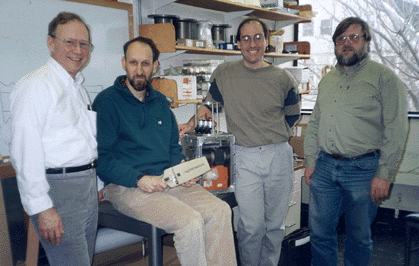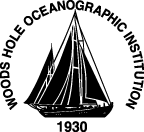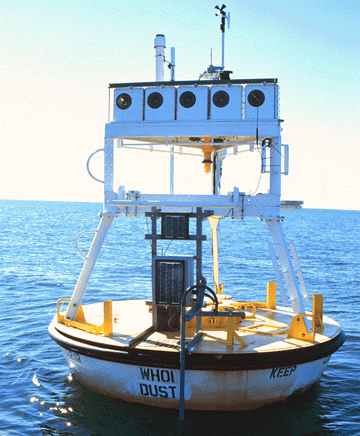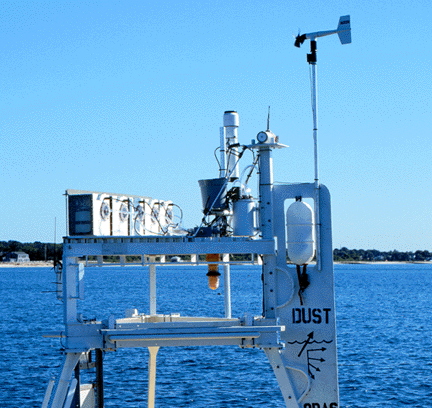
Welcome to the WEB site
Woods Hole Oceanographic Institution.

 |
Welcome to the WEB siteWoods Hole Oceanographic Institution. |
 |
This WEB site will provide both a broad and detailed view of our recent projects. It will also briefly describe our current project.
We will begin with an overview of our research using an article that appeared in the WHOI 1998 Annual Report below. Also available at this site are an article that was published in EOS ("Aerosol Sampling from Ocean Buoys", Sholkovitz et al., vol. 79, No. 3, Jan. 20, 1998), a 'poster' providing background information on the group's aerosol sampling efforts, and an abstract of a detailed technical report which describes the design of our buoy-mounted aerosol sampler (Sholkovitz et al., 1998, WHOI Technical Report No. WHOI-98-01).
Photographs of our buoy-mounted aerosol sampler included in the articles will allow readers to get a better view of our sampler.
 Please see our latest work
and progress report as of March, 1999.
Please see our latest work
and progress report as of March, 1999.
For more information contact: esholkovitz@whoi.edu
| Aerosols, an assembly of solid or liquid particles suspended in air, range in size from 0.001 to over 100 µm (1 µm = 1 millionth of a meter). The most common types of aerosols are mineral dust, seasalt particles, organic particles, soot, fine cloud condensation particles, and clouds. Natural aerosols are generated by oceans, desert, soil, vegetation, forest fires, and volcanoes. Aerosols also come from man-made activities, such as gasoline, oil, coal and charcoal combustion, biomass burning, cement production, smelting and agriculture. Aerosols also form when gases are converted to fine particles in the troposphere. The formation of non-seasalt sulfate aerosols from the oxidation of gaseous sulfur dioxide (SO2) is the most prominent example. |
Known to each other as the Dustbusters or the Aero-Souls, WHOI scientists and engineers - Edward Sholkovitz, Geoffrey Allsup, Richard Arthur, David Hosom, and Mike Purcell - are combining their expertise to design, build and test aerosol samplers and sensors for deployment on ocean buoys. While this report highlights technology, the scientific questions being addressed are fundamental in nature and have a large range of applications in marine and atmospheric sciences.
Aerosols and the Oceans. Aerosols - particles suspended in air - play substantial roles in the earth's radiation balance, climate and atmospheric chemistry. Aerosols are also involved in important biological and chemical processes in the oceans as illustrated with the following examples.


Why use a buoy? Dust is deposited on the oceans in short episodic events and in strong seasonal pulses. Hence, shipboard studies of upper ocean biology and chemistry have rarely coincided with a dust deposition event. Thus sprang the idea of using buoys as platforms for more precise sampling of continental dust falling on the oceans. In addition,
Our sampler tested and performed as designed for seven months in the field: four months on the AEROCE (Atmosphere/Ocean Chemistry Experiment) tower in Bermuda and three months on a buoy moored off Woods Hole. The tower and buoy were instrumented for wind speed and direction, rate of precipitation and rain detection. A wireless two-way communications modem was added to the buoy system, thus enabling us to monitor the sampling progress, to remotely change the sampling parameters, and to download the meteorological data.
We first needed to determine if our sampler gave results for aerosol compositions which are consistent with those obtained by an established aerosol sampler. This proved to be the case on the Bermuda tower where a side-by-side comparison with more traditional aerosol samplers were carried out. As the time record in the tower photograph shows, both the WHOI and AEROCE samplers picked up the large pulse of particulate Fe in early October; this aerosol's reddish brown color indicates an African origin.
Future Directions. The next logical step is to mount an engineering and science test on an open ocean buoy. The Bermuda Testbed Mooring, a buoy 80 km southeast of Bermuda, would be an ideal location because of the large and predictable seasonal signal, the summer transport of dust from Africa to Bermuda. Our aerosol sampler would nicely compliment the in-water samplers and sensors currently deployed there.
We are now designing a new carousel capable of generating a 50 place set of aerosol-embedded filters from a single compact module. Lastly, the Aero-Souls have recently been funded to design, build and test sensors which can measure aerosol concentrations in real-time from ocean buoys. X-ray fluorescence spectroscopy, a technique employed on the Mars Rover, offers great promise for the in situ elemental (Fe, K, Ca, Mg, Cl and S) analysis of aerosols from buoys. By using this non-destructive technique, applied to the analyses of aerosols embedded on filters, we can distinguish between mineral dust and seasalt aerosols.
Acknowledgment: The development of buoy-mounted aerosol samplers and sensors has been supported by the National Science Foundation (Ocean Technology and Interdisciplinary Coordination section) under grants OCE-94-23212 and OCE-97-11891.
Last Modified: 09 Oct 98
by Geoff
Allsup